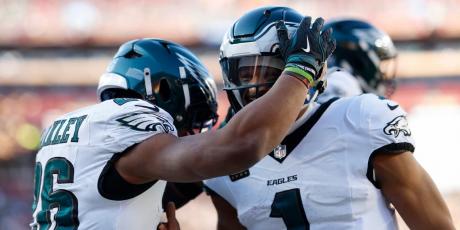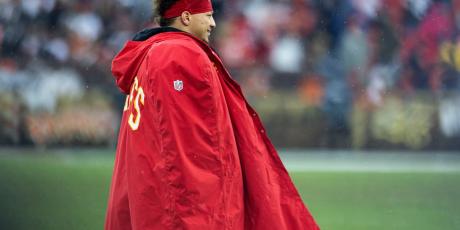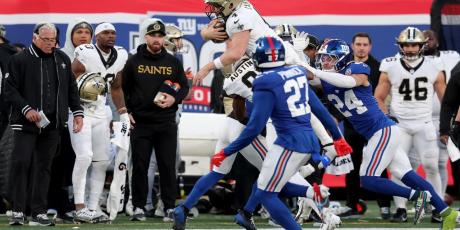The Training Room: 13 Draft-Worthy Fantasy Football Players With Injury Concerns

Beginning a four-part series discussing key injuries, this article highlights the key players who entered the 2024 season coming off of major injuries and surgeries. Some remain limited, while others have gone through the majority of their rehab timeframes and enter training camp on an upward trajectory. Read through for injury analysis on who you need to be aware of at current cost, and who you should be targeting with an injury discount.
Click here for more 2024 Injury Content!
Joe Burrow, QB CIN
Injury: Right Wrist, Scapholunate Ligament Repair
There were a lot of concerns regarding Joe Burrow's wrist entering the 2024 season. Would he ever be the same? Will the wrist give him problems regarding passing and accuracy? Of note after diving into the biomechanics of the role of the scapholunate as a thrower, the scapholunate ligament and repair is minimally tensioned throughout the cocking phase of a throw through the final “wrist flick” of the throw, only moving approximately 1.2-1.6 millimeters between the wrist throwing motion. Also, as long as surgery occurs rapidly after the initial injury, minimal scar tissue lays down and surgical outcomes are very good.
Burrow’s surgery occurred within three weeks of injury, a big difference from the bad recoveries that we have heard about where the surgery occurs three months or longer out from the initial injury because the player continued to play through it. The only concern I have about him into the 2024 season is how his wrist responds if he takes a sack and places his right hand down onto the ground to brace himself, bending his wrist backward with force and placing high tension on the repaired ligament. His throwing ability should be just fine, as evidenced by his recent throws in practice.
Last note, many people were worried about this injury based on comments from Dr. Slaughter, a wrist and hand orthopedic specialist and surgeon, who stated that this injury is worse than a bone fracture (with all due respect, this is common knowledge with orthopedic health care professionals and should not induce panic). What many failed to hear in the same interview was that Slaughter stated that he expects Burrow to return to full form by training camp (July) and have no long-term issues with throwing. As of right now, that is exactly where Burrow is in his recovery process. The timeline is estimated at 6-7 months for full recovery from surgery, and Week 1 marks nine months 13 days out from his surgery. Acquire without concern.
Related: A Healthy Joe Burrow Can Be a Top-10 QB Again
Kirk Cousins, QB ATL
Injury: Right Achilles Repair
Cousins has been cleared for full participation in training camp, which was anticipated. The primary concern regarding his return to football activity involves the fact that his rupture was on his right side, which is key for planting, pushing off, and generating force and velocity in his throwing pattern as a right-handed quarterback. Impact is unlikely to be seen on short throws, but could be seen in regards to accuracy in his intermediate to deep shots.
The good news is that his first 10 games are either in domes or projected “good weather” areas, and if we were to notice any issues it would likely be within his first few weeks. I am cautiously optimistic about his ability to remain healthy and sustain a positive regression passing attack for the Falcons’ weapons. Draft accordingly. Note that the primary concern in return to play is Achilles injury on the contralateral side within the first two years.
Aaron Rodgers, QB NYJ
Injury: Left Achilles Repair
In a similar situation as Cousins, I am more optimistic about Rodgers’ ability to return to form entering 2024 considering his repair was on the left side. Throwing accuracy and velocity should not be an issue for him, but scrambling and pocket maneuvering will be the main concerns, especially behind an old, injury-riddled offensive line. Hope for the best, because if he can stay healthy this Jets offense will boom.
Anthony Richardson, QB IND
Injury: Right AC Joint Separation, Surgical Repair
This one is a tough case because a significant AC joint injury that requires surgery to repair for a quarterback who already entered the league with some accuracy concerns should probably concern us. The AC joint is very complex and is pivotal structurally and dynamically for a throwing athlete. The good news is that these repairs typically produce good outcomes, but Richardson missed out on extensive repetitions and practice to improve his accuracy issues. Also to note, it should not be uncommon that he deals with shoulder soreness as he ramps up in throwing volume and velocity. We have already seen videos surface of him throwing 60 yards downfield and hitting his target, and he will likely continue to increase his volume and endurance leading up to Week 1.
I know the risk is there, but his per snap and per dropback fantasy upside is elite – Josh Allen type of tier, as Richardson scored 0.76 fantasy points per dropback which was first ahead of Allen’s 0.64. If he can stay healthy and avoid big hits (possibly learn how to play more like Lamar Jackson, getting down when wise), he will be a top-five scorer. I understand fading at his current cost in order to snag another high-upside quarterback like Kyler Murray or Jordan Love later on, but if you do desire to draft Richardson at his current cost, draft with confidence.
Related: Anthony Richardson Carries a Steep Price but Mega Upside
Daniel Jones, QB NYG
Injury: Right ACL Reconstruction
Week 1 marks nine months and 17 days out from his ACLR, allowing ample time for him to ramp up in camp. In fact, he was recently fully cleared for camp participation, including contact, in late July. I anticipate his primary limitation being scrambling ability, volume, and efficiency within the first half of the season. The bad news is that Brian Daboll’s offense averaged over seven rush attempts per game with Jones at quarterback, though the good news is that if there is a large regression early on we will still likely see Jones rush close to three to four attempts, if not more, per game.
Taking into account that Jones has an elite weapon now in Malik Nabers, as well as a presumably healthy Wan'Dale Robinson, should boost his passing statistics as long as the ACL does not hinder his passing ability. Considering it occurred on his right side, which is key for pushing off and generating force and velocity in his throws, as well as transitioning weight from back foot to front foot, anticipate inaccuracy issues and rust throughout August with the hope that he can knock a lot of that rust off by Week 1 of the season. He is very cheap in drafts which makes him tempting to acquire, especially for best ball, despite the risk that the Giants may eventually bench him if he continues to struggle.
Deshaun Watson, QB CLE
Injury: Right Glenoid Avulsion Fracture, Surgery
On paper, any mechanical issues within his shoulder should have been addressed with the surgery that he underwent last season. I understand that he has had some accuracy issues and we have not seen him return to his old Houston self as a quarterback, but note that despite his struggles he did have four out of five healthy games score inside the top 15, and he is currently going around QB20 in ADP. Cleveland plans to go pass-heavy once again and from an injury standpoint, I do believe that we can invest in Watson for the 2024 season with low concern on his right shoulder.
Nick Chubb, RB CLE
Injury: Left ACL, MCL, Meniscus
Chubb underwent two surgeries for his knee, with the first one coming on September 14 to repair his meniscus and MCL with six weeks of non-weight bearing for healing, then the second surgery to address his ACL tear on November 14. The initial thought was that he had an ACL reconstruction, however, the wording that has continued to be used has been “ACL repair”, so I am genuinely unsure if they did reconstruct the ACL or were able to repair it. Reporters often get the two mixed, but several sources have all used the same repair term.
His timeline would be lessened by one to two months with the repair compared to the reconstruction, with Week 1 marking nine months 26 days from the second surgery. We have since seen video surface of him sprinting straight-line at full speed and squatting over 500 pounds, however, we also know that as of early August, he has barely begun lateral agility training, cutting, change of direction, and has not been able to return to football specific activity with only five weeks to go until the season begins.
While it is difficult to bet against Chubb, given his current timeframe and the information that we have, I do believe the Browns will be conservative with him and keep him on PUP to start the season to ease him in. Jerome Ford and Pierre Strong Jr. have been performing well in camp, and they also recently found out that D’Onta Foreman’s neck injury is minor despite the hospital visit (precautionary) and did not result in a concussion. Chubb’s ADP is borderline too high now that he has been rising towards the RB32 range, but if you view these draft picks as “I am drafting this player in this range for his mid-season to playoff production”, then the cost does not hurt as badly. The downside is we should not anticipate much, if any, receiving production for Chubb and if drafting him, you are likely relying on a Gus Edwards-esque high touchdown production season from him. Caution as his ADP continues to rise. While this is Nick Chubb we are talking about, he is now 28 years old coming off of his second significant knee injury on a pass-heavy team that can slowly ease him in without the need to insert him back into his old role.
Jonathan Brooks, RB CAR
Injury: ACL Reconstruction
Recent news poured cold water on the Brooks hype entering the 2024 season, with Dave Canales stating that the Panthers are going to keep him out of the entire preseason while eyeing close to Week 3-4 for his NFL debut. Week 1 marks eight months and 29 days out from his surgery, so it makes sense that Carolina wants to slow-play the return of their promising rookie. This means that he will miss valuable reps through the preseason and likely faces a gentle easing in throughout the first and probably second quarter of the NFL season, which does not sound good for the RB22 off the board. It appears that the news has caused him to drop a good amount already as he has fallen closer to the RB26 range, and if he continues to fall I would not mind betting on the discounted price due to a similar mentality to the Chubb pick – this pick is more for mid-season to playoff production.
He fits Canales' offense perfectly and has some decent projected targets once he is full-go, as long as projections can be made off of what Canales did in Tampa Bay. This news of a delay to the start of his season will likely make him a better pick at cost. Chuba Hubbard remains one of the better late-round picks due to his early-season role and is dependent on how quickly Brooks gets ramped up once fully cleared.
Related: Fantasy Implications of Jonathon Brooks as a Panther
Nico Collins, WR HOU
Injury: Shoulder Labral Repair, Surgery
Nico Collins had off-season labral repair in one of his shoulders (rumored right side but not confirmed) and was slow to return to full go until July, which fits a standard protocol and timeline for return to play. These surgeries for wide receivers produce great outcomes without long-term issues, so this one is not one to worry about. He has been full go in camp.
Mike Williams, WR NYJ
Injury: ACL Reconstruction
Week 1 marks 10 months and 15 days out from Mike Williams' ACL reconstruction. Robert Saleh has already stated that they will be taking a slow approach with Williams, very similar to Breece Hall’s return to play, which makes me believe that he will have a slow snap count ramp-up within the first four weeks and then move into a full-time starter role as long as there are no setbacks. While he carries high injury risk given his playstyle and coming off of an ACLR, his pricetag is so cheap that he could pay off as the second weapon in the Jets offense. Likely more boom or bust, but again he comes with a cheap price tag. He's a low-risk gamble at cost, just expect a slow start to the season for him.
George Kittle, TE SF
Injury: Core Muscle Repair Surgery
George Kittle played through the majority of 2023 with a core muscle tear since Week 10 of last season, undergoing surgery in February after the Super Bowl. Despite this, he still had a 21% target share, including 18.5% in the red zone, the most receiving yards for tight ends, third highest air yard share with 22.7%, second highest ADOT with 9.5 yards per target, and the most yards per route run with 2.30. The good news is that these surgeries come with great outcomes with very few reinjuries and long-term concerns.
The main concern is simply Kittle’s long history of injuries and playstyle, but this specific surgery should not lead to further issues entering the 2024 season. Draft accordingly. It is incredible that he still put up 1,000 yards with a core muscle tear midway through the season.
Tucker Kraft, TE GB
Injury: Pec Tear, Surgery
Tucker Kraft underwent a pec repair sometime in March after tearing it while bench pressing. These repairs typically come with close to a 5-6 month timeframe for return to sport, which fits his current timeframe of beginning limited football activity and practice in this second week of August. There is a decent chance that Kraft is not ready to contribute to begin the season, leaving the door open for Luke Musgrave to win back the TE1 position for Green Bay.
Both turn into tricky draft selections given the Packers desire to spread the ball out and have a committee approach to seemingly every position. While they are cheap, I would prefer to avoid these GB tight ends for fantasy this season, adding the fact that there is an anticipated 15-20% production regression coming off of the pec repair for pass catchers.
T.J. Hockenson, TE MIN
Injury: ACL, MCL Tear
T.J. Hockenson underwent his ACL reconstruction on January 29 due to a delay in allowing his MCL to heal, leaving his timeframe for Week 1 at seven months 11 days out from his surgery. I do not see a reasonable way that Hockenson is active for Week 1 despite Kevin O’Connell stating that he is ahead of schedule. It seems more plausible that he will be active after Minnesota’s Week 6 bye, marking eight months 29 days out from his surgery for a Week 7 debut.
While I am typically against drafting players who have a season delay coming off of an ACLR, there is a good point that he is currently coming off of the board as the TE16, and even if he returns to 80% of his prior role within this offense, his upside is significantly higher than any other pick around his current range. Last season, his utilization was phenomenal with a 24% target share, including 17.6% in the red zone, with the second-most targets, second-highest air yard share with 23%, and the fourth-most receiving yards for tight ends. You will be drafting him for a late playoff push and then his fantasy playoff production, but by then his production should far outweigh his ADP cost. Thus, I am fine with drafting him at cost with this mindset and hoping that the scheme and his strong utilization outweigh any risk of having Sam Darnold or rookie JJ McCarthy at quarterback.
Thank you for reading through the first article of this series and keep an eye out for an upcoming article on key injuries that have occurred so far throughout OTAs and camp as we enter pre-season games. Follow me on X/Twitter @jmthrivept for more updates.























